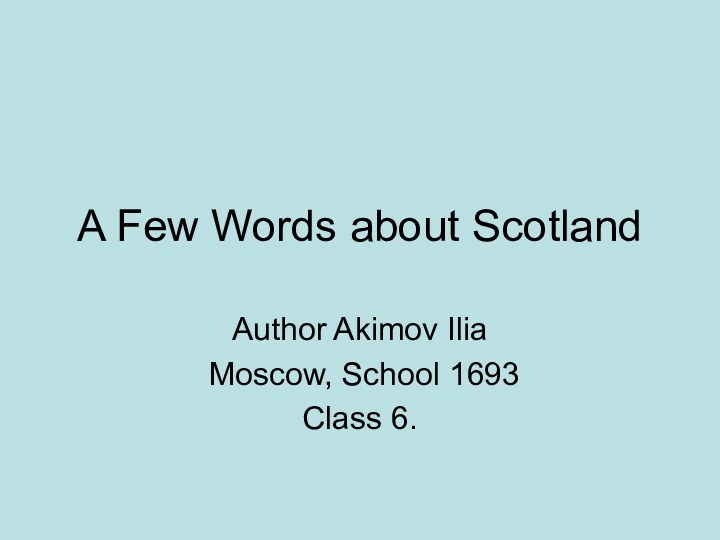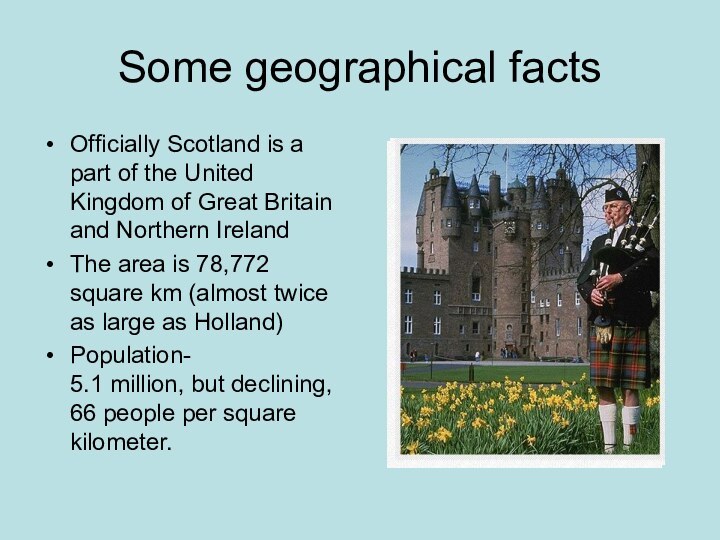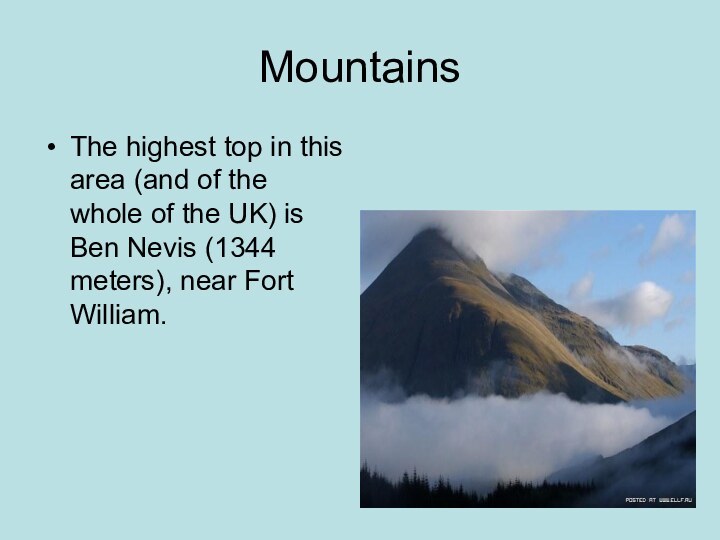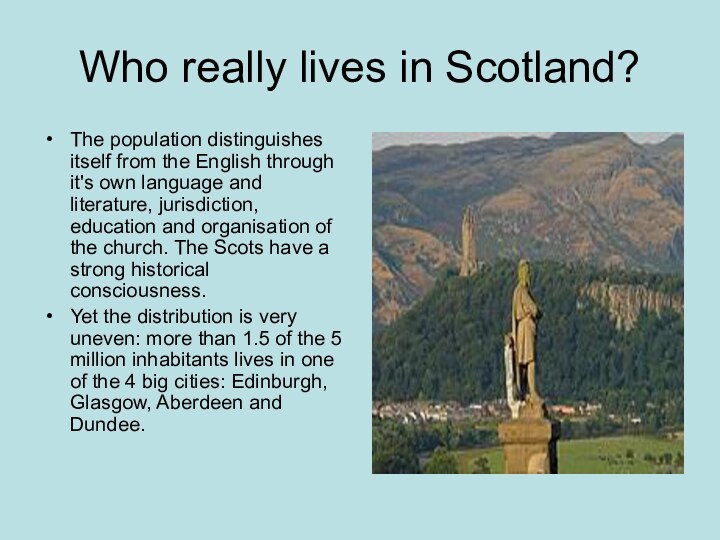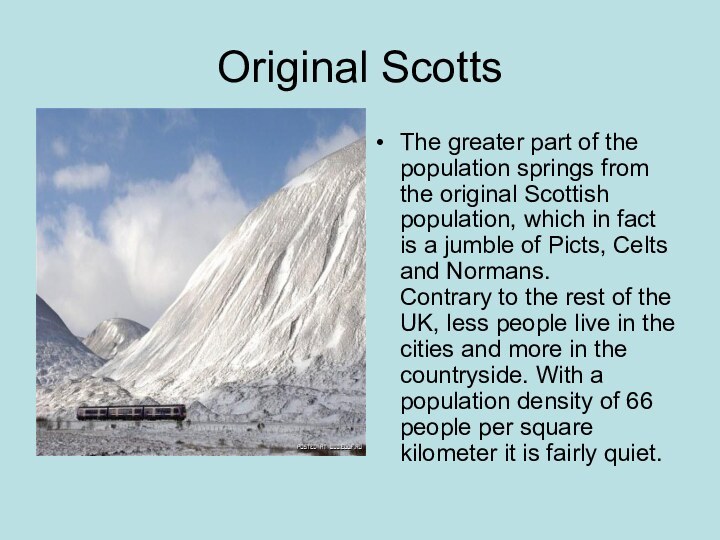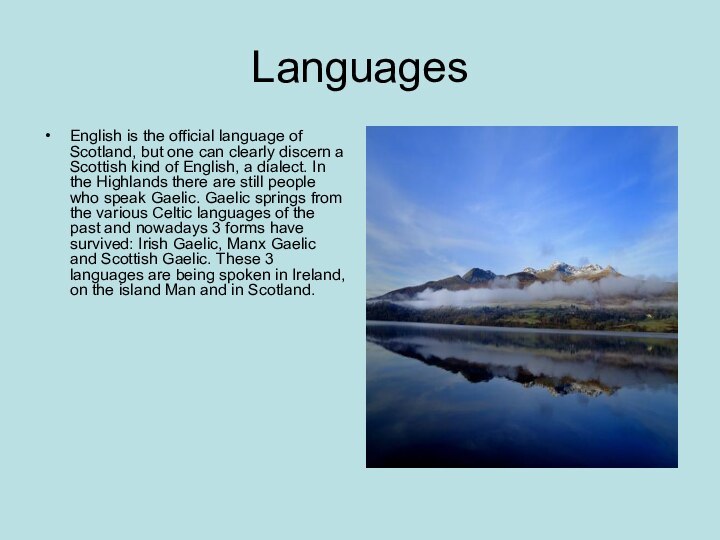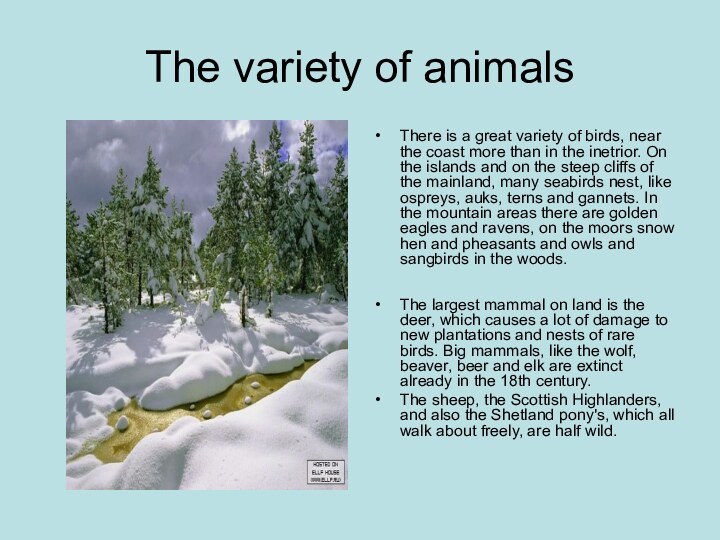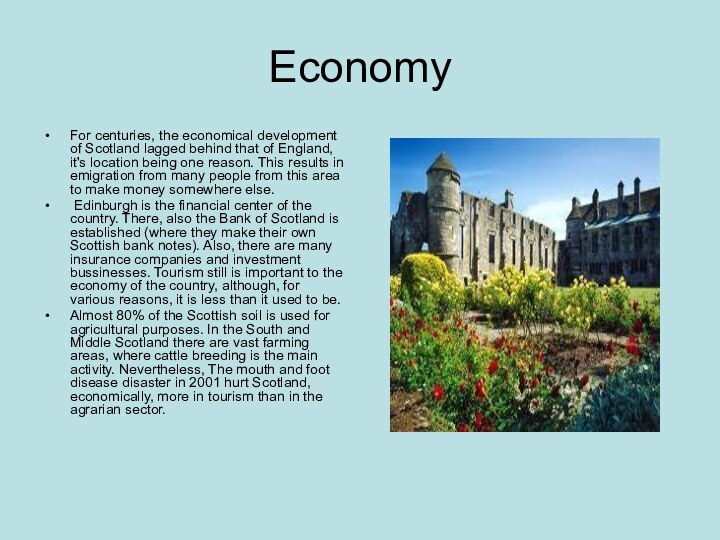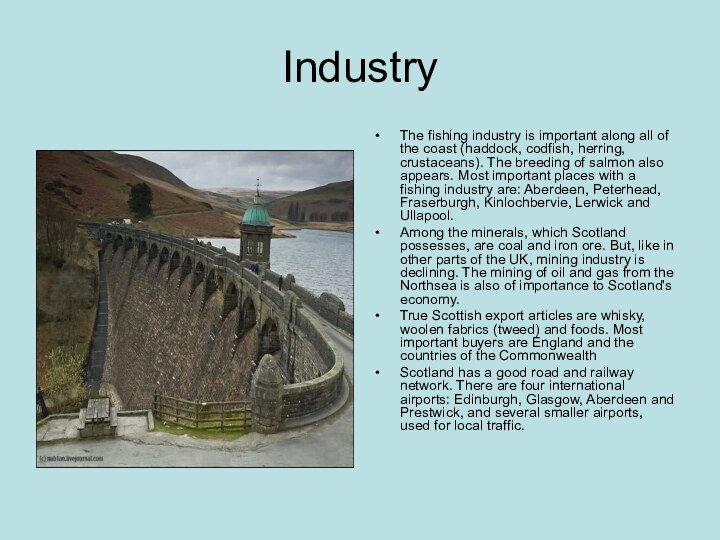Слайд 2
Some geographical facts
Officially Scotland is a part of
the United Kingdom of Great Britain and Northern Ireland
The
area is 78,772 square km (almost twice as large as Holland)
Population-
5.1 million, but declining, 66 people per square kilometer.
Слайд 4
Some more geographical information
Scotland makes up for almost
35% of the surface of the UK (78.722 sq.
km.), but only 9.5% of the population lives there.
Слайд 5
The borders
Scotland and it's offshore islands are the
northern part of the British island. On the west
and the north coast the Atlantic forms the border and in the east coast the Northsea. In the south the border with England goes over the Cheviott Hills, for 90 kilometers.
Слайд 6
Amazing facts
The west coast is, in a straight
line, 416 km. long, but in reality (because of
the many bays) 3200 km. Scotland counts 790 islands, of which 130 are inhabited.
Geografically Scotland consists of 2 parts: the mainland and the islands. On the mainland, one can discern 3 clear landmasses: the northen Highlands, the central Highlands and the Lowlands.
Слайд 7
Mountains
The highest top in this area (and of
the whole of the UK) is Ben Nevis (1344
meters), near Fort William.
Слайд 8
Who really lives in Scotland?
The population distinguishes itself
from the English through it's own language and literature,
jurisdiction, education and organisation of the church. The Scots have a strong historical consciousness.
Yet the distribution is very uneven: more than 1.5 of the 5 million inhabitants lives in one of the 4 big cities: Edinburgh, Glasgow, Aberdeen and Dundee.
Слайд 9
Original Scotts
The greater part of the population springs
from the original Scottish population, which in fact is
a jumble of Picts, Celts and Normans.
Contrary to the rest of the UK, less people live in the cities and more in the countryside. With a population density of 66 people per square kilometer it is fairly quiet.
Слайд 10
Languages
English is the official language of Scotland, but
one can clearly discern a Scottish kind of English,
a dialect. In the Highlands there are still people who speak Gaelic. Gaelic springs from the various Celtic languages of the past and nowadays 3 forms have survived: Irish Gaelic, Manx Gaelic and Scottish Gaelic. These 3 languages are being spoken in Ireland, on the island Man and in Scotland.
Слайд 11
How to communicate in Scotland?
The speakers of these
languages are called Gaels (formerly Celts). About 60.000 people
in Scotland still speak it, so not more than 1% of the total population!
A few centuries ago there were 3 more languages besides English: Pictic, Gaelic and Norwegian. In the present Scottish language many words pop up from these 3 languages.
Слайд 13
Climate
Scotland lies on the edge of the European
continent and is surrounded by water on 3 sides.
It has a moderate seaclimate with soft winters and cool summers.
Average summer highs are about 19 degrees and winter temperatures rarely drop below 0 degrees.
Generally, there is snow in the higher areas from December until March. For the most sunshine and a minimum of rain, one has to go there in May or June. July and August are hotter, but also more wet and there are countless midgets.
Слайд 14
The weather
For the last few years the weather
is very unpredictable and different than it used to
be: too much rain and low temperatures. We never went for the weather, but seem to have been quite lucky: most days were dry and on almost every day we saw at least a bit of sunshine.
In Scotland, the weather can show every season in a single day! Even on the sunniest of days care needs to be taken on the hills and mountains. On a mountain, within only 5 minutes, a mist can envelope a walker and make navigation difficult. On the other hand, brooding clouds can ease to spectacular shafts of bright sunlight.
Слайд 15
Flora and Fauna
The Highlands are barren and unhospitable.
The landscape consists of infertile plains without trees. The
vegetation includes heather, fern, a variety of grasses, Juneper berry and similar small bushes.
Some 4.000 years ago, there were mainly pine trees (Scots pine), but deforestation, intensive grazing by sheep and changes in climate, have replaced the once extensive woods with a thick layer of peat. Reforesting has begun, but the new woods are quite one-sided and monotonous.
Слайд 16
The variety of animals
There is a great variety
of birds, near the coast more than in the
inetrior. On the islands and on the steep cliffs of the mainland, many seabirds nest, like ospreys, auks, terns and gannets. In the mountain areas there are golden eagles and ravens, on the moors snow hen and pheasants and owls and sangbirds in the woods.
The largest mammal on land is the deer, which causes a lot of damage to new plantations and nests of rare birds. Big mammals, like the wolf, beaver, beer and elk are extinct already in the 18th century.
The sheep, the Scottish Highlanders, and also the Shetland pony's, which all walk about freely, are half wild.
Слайд 17
Economy
For centuries, the economical development of Scotland lagged
behind that of England, it's location being one reason.
This results in emigration from many people from this area to make money somewhere else.
Edinburgh is the financial center of the country. There, also the Bank of Scotland is established (where they make their own Scottish bank notes). Also, there are many insurance companies and investment bussinesses. Tourism still is important to the economy of the country, although, for various reasons, it is less than it used to be.
Almost 80% of the Scottish soil is used for agricultural purposes. In the South and Middle Scotland there are vast farming areas, where cattle breeding is the main activity. Nevertheless, The mouth and foot disease disaster in 2001 hurt Scotland, economically, more in tourism than in the agrarian sector.
Слайд 18
Industry
The fishing industry is important along all of
the coast (haddock, codfish, herring, crustaceans). The breeding of
salmon also appears. Most important places with a fishing industry are: Aberdeen, Peterhead, Fraserburgh, Kinlochbervie, Lerwick and Ullapool.
Among the minerals, which Scotland possesses, are coal and iron ore. But, like in other parts of the UK, mining industry is declining. The mining of oil and gas from the Northsea is also of importance to Scotland's economy.
True Scottish export articles are whisky, woolen fabrics (tweed) and foods. Most important buyers are England and the countries of the Commonwealth
Scotland has a good road and railway network. There are four international airports: Edinburgh, Glasgow, Aberdeen and Prestwick, and several smaller airports, used for local traffic.
